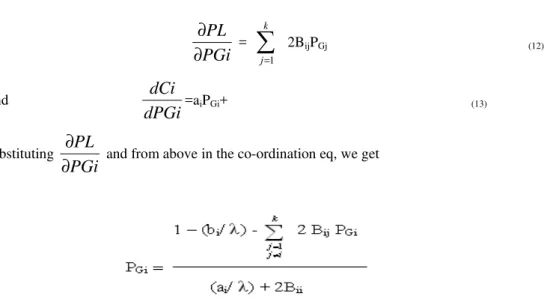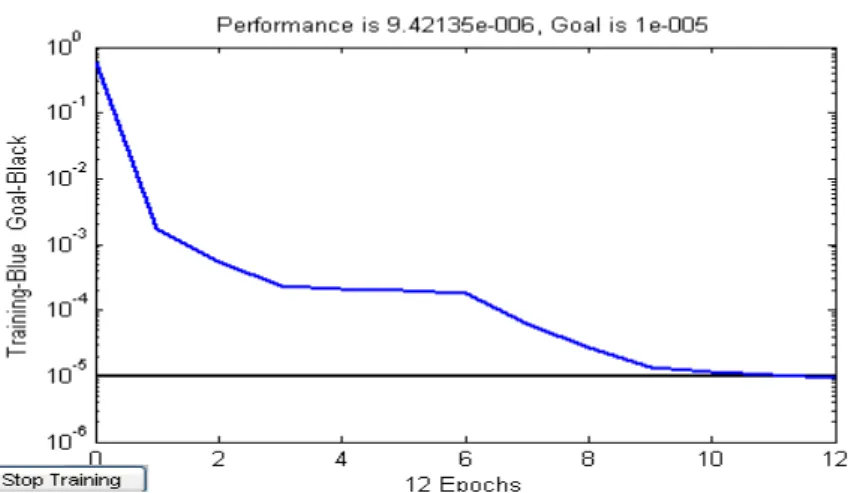APPLICATION OF ANN IN
ECONOMIC GENERA-TION
SCHEDULING IN IEEE 6-BUS
SYSTEM
MISS SWEEKA MESHRAM
S.G.S.I.T.S Collage,Indore Electrical Engineering Department
Madhy-pradesh,India
OMPRAKASH SAHU
Jabalpur Engineering Collage,Jabalpur Electrical Engineering Department
Jabalpur,Madhy-pradesh,India,
Abstract
In this paper training data for the training of artificial neural network is obtained by the classical Kirchmayer method and this training data is then given to the ANN for the training. After the training power generation (PGi) for any power demand (PD) can be calculated. In this paper training of artificial neural network by OFF-LINE Training for test system, IEEE 6-bus system.
1.Introduction
The size of electric power system is increasing rapidly to meet the energy requirements. A number of power plants are connected in parallel to supply the system load by interconnection of power stations. With the development of grid system it becomes necessary to operate the plant unit most economically. The economic generation scheduling problem involves two separate steps namely: (1) Unit commitment and
(2) Online economic dispatch.
The unit commitment is the selections of unit that will supply the anticipated load of the system over a required period of time at minimum cost as well as provide a specified margin of the operating reserve. It is not economical to run all the units available all the time to determine the units of a plant that should operate for a particular load is the problem 0f unit commitment (UC). This problem is of importance for thermal plants as for other types of generation such as hydro; their operating cost and start up times are negligible so that their on-off status is not important.
A simple but sub optimal approach is to impose priority ordering, wherein the most efficient unit is loaded first to be followed by the less efficient units in order as the load increases. A straight forward but highly time consuming way of finding the most economical combination of units to meet a particular load demand, is to try all possible combinations of units that can supply this load; to divide the load optimally among the units of each combination by use of the combination equations, so as to find the most economical operating cost of the combination; then to determine the combination the combination which has the least operating cost among all these.
2. Problem Formulation
The main aim in the economic dispatch problem is to minimize the total cost of generating real power (production cost) at various stations while satisfying the loads and losses in the transmission links. By fitting a suitable degree polynomial, an analytical expression for operating cost can be written as
Ci =
2
1
aiPGi + biPGi +di Rs/hour (1)
Where, Ci = operating cost of i generating unit,
i = no. of generating unit,
ai = a measure of losses in the system, bi = the fuel cost and
di = the salary, wages, interest and depreciation.
Let us assume that it is priori, which generators are to run to meet a particular load demand on the station. Obviously
∑ PGi, max≥ PD (2)
Where PGi, max =the rated real power capacity of the ith generator and
PD = is the power demand on the station.
The total operating cost, which we have to minimize, can be given as:
C = Ci(PGi) (3)
The optimal dispatch should be such type that total power generation should be equal to total transmission losses plus power demand, i.e.
PGi – PD – PL = 0 (4)
Where
k = Total number of generating plants PGi = Generation of ith plant
PD = Sum of load demand at all buses (system load demand)
PL = Total system transmission loss
To solve the problem, we write the Lagrangian as:
£ = Ci(PGi) - λ [ PGi – PD - PL] (5)
For optimum real power dispatch,
PGi
∂
∂
L
=dPGi
dCi
– λ + λ *
PGi
PL
∂
∂
= 0 (6)
i = 1, 2, 3…... k
Rearranging equation and recognizing that changing the output of only one plant can affect the cost at only that plant,
= k i1
= k i1
= ki1
=k
(7) Or
dPGi
dCi
*Li = λ, i = 1, 2,………….k (8)
Where,
Li is called the penalty factor of ith plant.
The Lagrangian multiplier λ is in rupees per megawatt-hour, when fuel cost is in rupees per hour. The general form of the loss formula using B-coefficient is
PL=
=k
m 1
=k
n1
PGmBmnPGn (9)
Where
PGm, PGn = real power generation at mth, nth plants
Bmn = loss coefficient which are constant under certain assumed operating Conditions.
If PGs are in megawatts, Bmn are in reciprocal of megawatts.
Equation for the transmission loss may be written in the matrix form as
PL = PGTBPG
Where (10)
It may be noted that B is a symmetric matrix. With the system power loss model as per eq.,
PGi
PL
∂
∂
=
PGi
∂
∂
[
=
k
m 1
=k
n 1
PGmBmnPGn ] (11)
And
dPGi
dCi
=aiPGi+ (13)
Substituting
PGi
PL
∂
∂
and from above in the co-ordination eq, we get
(14)
For any particular value of λ eq. 14 can be solved iteratively by assuming initial values of PGis. Iterations
are stopped when PGis converge within specified accuracy.
3. Data for IEEE-6 Bus System
Table -1:- Bus Data of IEEE 6-Bus Test System:
Bus No. Bus Type Pg Qg PL QL Vmag Vang
1. 0 0 0 0 0 1.05 0
2. 1 0.45 0.24 0 0 1.07 0 3. 2 0 0 -.275 -.065 1 0
4. 20 0 0 0 0 1 0
5. 2 0 0 -0.15 -0.09 1 0 6. 2 0 0 -0.25 -.005 1 0
Table -2:- Line Data of IEEE 6-Bus Test System:
Line No. Between Buses R in P.u. X in P.u. Half-line Charging susceptance in p.u
1. 1 - 6 0.123 0.518 0.03
2. 1 - 4 0.080 0.370 0.010
3. 2 - 3 0.0723 1.05 0.022
4. 2 - 5 0.282 0.064 0.12
5. 3 - 4 0 0.133 0.33
6. 4 - 6 0.097 0.407 0.01
Fig.1 Line Diagram of IEEE 6-Bus Test System:
4. Results
Fig 2 Performance of Levenberg-Marquardt BP Trained ANN Model for IEEE 6-Bus Test System
Fig 3 Performance of Levenberg-Marquardt BP Trained Model for IEEE 6-Bus Test System
5. Conclusion
Network as compared to Optimization method with constraint and bound. Classical Kirchmayer Method trains ANN very soon, it means it will also give very fast calculation of power generation at every power generating unit for different-2 load demand. ANN is able to give results with in a fraction of time.
References
[1] Nagrath I. J. and Kothari D. P., “Power System Engineering”, TMH Publications, New Delhi, 1994. [2] H. Hassoun Mohamad, “Fundamentals of Artificial Neural Networks”, PHI Publication, New Delhi, 1998.
[3] O. Mohammad, D. Park, R. Merchant, T. Dinh, C. Tong, A. Azeem, J. Farah, K. Cheung, “Practical Experiences with an Adaptive Neural Network Short-term Load Forcasting System ”, IEEE Transactions on Power Systems, vol. 10, no.1, Feb. 1995. [4] Wadhwa C. L., “Electrical Power Systems”, NAI Publications, New Delhi, 1995.
[5] Sadat Hadi, “ Power System Analyses”, Mc Graw Hill Publication, New Delhi, 1997. [6] Hussain Ashfaq, “Electrical Power Systems”, CBS Publications, New Delhi, 1994.
[7] Carpenter G. A. and Grossberg S., “Neural Dynamics of Category Learning and Recognition; Attention Memory Consolidation and Amnesia”, AAAS Symposium Series, 1986.
[8] Kusic George L., “Computer-Aided Power Systems Analysis” PHI Publication, New Delhi, 1998.
[9] M. A. Pai, “Computer Techniques in Power System Analysis” The Mc Graw Hill Publication, New Delhi, 1974
[10] S. N. Sivnandan, S. Sumpathi, S.N. Deepa, “Introduction to Neural Networks using MATLAB 6.0” The Mc Graw Hill Publication, New Delhi
[11] J. H. Park, Y. S. Kim, I. K. Eom, and K. Y. Lee, “Economic Load Dispatch for Piecewise Quadratic Cost Function Using Hopfield Neural Networks” IEEE Transactions on Power System apparatus and Systems, vol. 8, no.3, pp. 1030-1038, Feb. 1993. [12] Kirchmayer L. K., “Economicn Operation of Power Systems”, John Willey and Sons, New York, 1958.
[13] Mohammad Mohatram, “Application of Artificial Neural Network in Economic Generation Scheduling of Thermal Power Plants” Waljat Colleges of Applied Sciences, Muscat, Sultanate of Oman, with Birla Institute of Technology, Mesra (Ranchi), India
[14] A. Sode-Yome and N. Mithulananthan, “Maximizing static voltage stability margin in power systems using a new generation pattern,” in Proc. Australasian Universities Power Engineering Conf., Brisbane, Australia, Sep. 26–29, 2004.
[15] Deepak Mishra, Amit Shukla, and Prem K. Kalra “OR-Neuron Based Hopfield Neural Network for Solving Economic Load Dispatch Problem,” Department of Electrical Engineering Indian Institute of Technology Kanpur, India
[16] A. Sode-Yome and N. Mithulananthan, “Generation Direction Based Optimization Technique for Power System Voltage Stability Study”, Australasian Universities Power Engineering Conference 2005, University of Queensland, Brisbane, Australia, Sep. 25-28, 2004.

